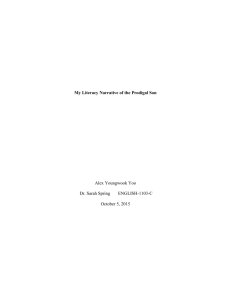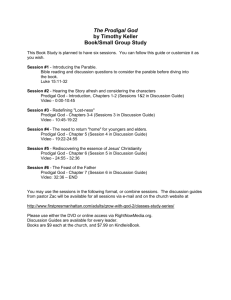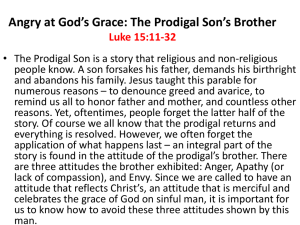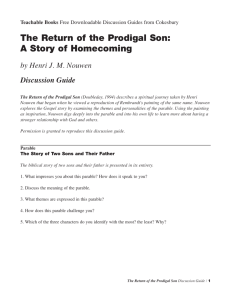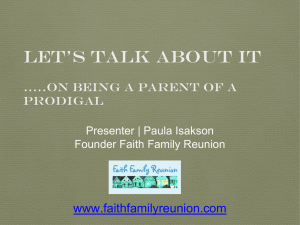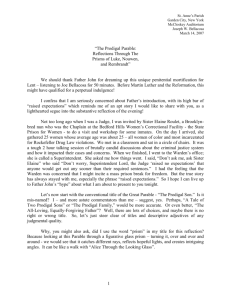Week 17
advertisement
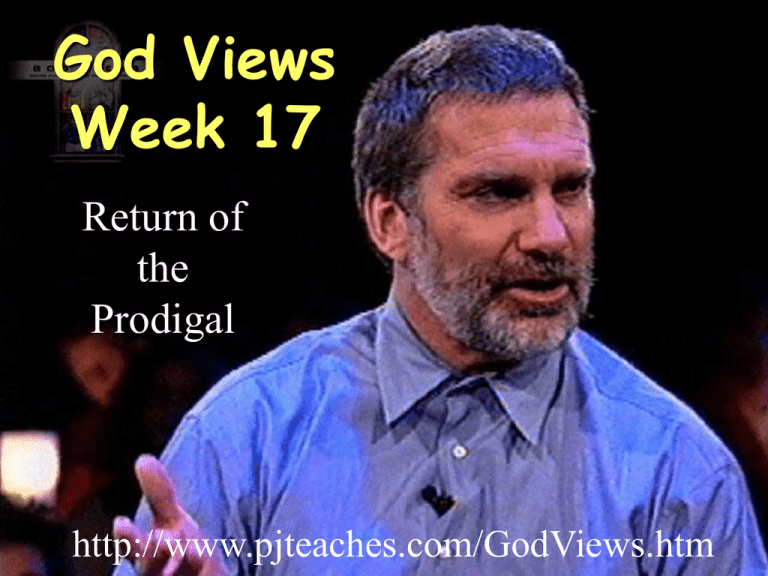
God Views Week 17 Return of the Prodigal http://www.pjteaches.com/GodViews.htm Henri J. Nouwen (19321996) is one of the most beloved writers in the area of Christian spirituality the twentieth century produced. He wrote about his own spiritual journey—both triumphs and tribulations—with such openness of heart that he made it easy for the reader to be honest as well. In 1983 Nouwen discovered Rembrandt’s The Return of the Prodigal Son. The painting absorbed his thoughts for several years. Eventually, it inspired one of his most important books, The Return of the Prodigal Son, A Story of Homecoming. In it he chronicles his personal reflections on the painting and his own life. Rembrandt’s painting shows the prodigal son being embraced by his father. The son is kneeling. His clothes are dirty and little more than rags. One shoe is missing. The other is worn. His head is shaved. The father’s hands are gently placed on his son’s back. He is draped by a red cape—the color perhaps being symbolic to Rembrandt of the heart, or compassion. The son is engulfed by the father’s love. There are three other characters in the painting. Two are not identified. They are observers. (Perhaps one is a servant, the other a friend of the father.) But there is no mistaking the third: it is the distant and aloof older brother. His eyes are downcast and reflect distance and displeasure. Nouwen believed that the painting did more than portray the climactic scene from Jesus’ famous parable. It questioned him. Who are you? Which of the figures do you identify with? Nouwen’s initial thoughts were that he didn’t know what it would be like to be the prodigal son, held and loved by the father. He felt more like one of the two unidentified onlookers. Nouwen confessed, “For years I had instructed students on the different aspects of the spiritual life…But had I, myself, really ever dared to step into the center, kneel down, and let myself be held by a forgiving God?” Such an honest statement by a respected writer on the topic of God’s love is unexpected. Perhaps it will motivate us to invest some time reflecting on Rembrandt’s painting, while considering with which of the figures we most readily identify. Let’s take a closer look, as we consider our place in the picture. The Prodigal A Pulitzer Prize-winning author (Richard Rhodes) once said that all stories are the same. A person falls in a hole and struggles to get out. I believe he is onto something. Ever since Adam, the primary The Prodigal struggle of humankind is to get out of the hole into which we have fallen. The Prodigal I believe this is why Jesus’ story of the prodigal son is so powerful. We each identify with the notion of being separated from God because of self-centered choices. We long to believe that God’s love is like that of the The Prodigal Prodigal’s father—a pursuing and outstretched love. We know that what is best for us is to give up any notion of happiness apart from God and to come home. The Prodigal Perhaps some of us are at a place of strong identification with the prodigal son at some stage of his journey: moving away from home to pursue happiness apart from God; in the midst of prodigal living; in the pig pen of despair; or The Prodigal facing back toward home, hoping only to participate outside the Father’s home as a laborer. Perhaps some have gone through all these cycles and are enjoying the surprising embrace of the Father’s love. The Older Brother Some of us may identify with the older brother. We have never left our Father’s house, but neither have we they enjoyed the full embrace of his love. Older sons often have dark feelings that fester in their hearts: envy at the liberties The Older Brother taken by “brothers” in Christ, judgment, condemnation, and bitterness. Older brothers are physically present in the Father’s house, but their hearts are in a faraway country, imprisoned by self- The Older Brother righteousness. Their resentment is like the attitude of the Pharisees and teachers of the law who opposed Jesus. The Father Maybe there are others in the group who can even identify with the Father. Their love has become strong and mature. Not only can they imagine reaching out to a prodigal child (and perhaps they The Father have), but they can also do as the father did for the second child. They can imagine reaching out to the older son as well. If you carefully reread Luke 15:28, you will observe that not only did the father go The Father out for the younger son, he went out for the older brother as well. It could be argued that a better name for this parable would be “The Father’s Love” rather than “The Prodigal Son.” In Jesus’ most powerful parable, the younger son made a change when confronted by the depth of his father’s love. As Nouwen wrote: “People who have come to know God do not deny the darkness, but they choose not to live in it. They claim that the light that shines in the darkness can be trusted more than the darkness itself….” They move back home and see their Father in a whole new light. In this true view of God, we consider the image of the Prodigal’s father as a clear reflection of the love of God. And we are invited to realize what Nouwen did. God is not hard to find. In fact, He is the one doing the looking. It is we who linger outside, or even in hiding, needing to learn to trust a true view of our real Dad. It’s the only way to get out of the hole we have each fallen into. In this DVD segment, Curt performs a modern-day adaptation of Jesus’ parable of the prodigal son. It is a powerful story about the love of a father for his child—a love so strong that it cannot be quenched by the child’s rejection of him or other sinful behaviors. Why do you think Jesus’ parable of the prodigal son has become a classic summary of the gospel message? If there had been an older brother in this story, what do you think his reaction would have been? In what way(s) did Curt’s retelling of this parable touch you? Is anyone willing to share an experience from his life in which he was overwhelmed by unexpected grace? Bible Study Exercise 9-B Let us once again turn to the Bible. In the fresh light provided by Nouwen and Cloninger, and the artwork of Rembrandt, we will examine the parable of the Prodigal present in Luke’s gospel. Luke 15:11-32 Creation The doctrine of creation affirms the goodness and lavish love of the Creator and His desire to be with His creation. Jesus’ parable opens with the son being with his father in an Eden-like environment—a place of abundance where all conceivable needs can be met. Human Nature As a son, the prodigal is an image or reflection of the father. But also like the prototype, Adam, he desires autonomy and independence from his Father. He wants to be free of parental restraint and to spend his inheritance as he pleases—primarily for pleasures of the flesh, instead of spirit. The result of this “sin” is pictured as what the Human Nature Jews would view as the ultimate indignities—the distasteful work of feeding unclean animals, and having fallen so far as to desire to eat the food of pigs. Nature of God God exists in a community of love—as Trinity. Because of this love, He creates and invites His creation to be members of the family. The father in Jesus’ story desires for his children to live together with him sharing love and relationship. But he respects the free choice of his son and allows him to leave. The love of the father becomes the dominant theme of the rest of the story. Incarnation In this parable, the father does something very unusual. He leaves home, runs to his son, and throws his arms around him. He hugs a son who undoubtedly reeks of dirt and pig slop. In that culture, such an act would be perceived as debasing. It parallels Jesus’ self-emptying to embrace us as a servant. Redemption The father not only enters the world of the son but also brings him back home and provides him with a robe, ring, sandals, and a feast. Each was a sign of restored position and acceptance by the father. Solely as a result of the father’s grace, the son is restored. Summary Is this parable of Jesus really about the prodigal son? I don’t think so—at least this is not the primary focus. The story is about the father and his amazing love for both of his children. And consequently, it is about the lavish love of God. But do you know what you will find when you look up the meaning of the word “prodigal”? It means Summary “reckless,” “extravagant,” and “lavish.” Maybe “prodigal” is the right adjective. It’s about the prodigal (“lavish”) love of our heavenly Father.
